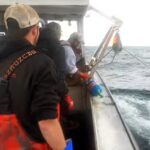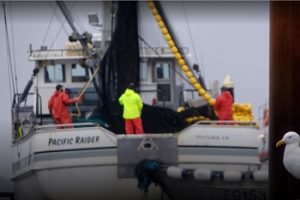Tag Archives: bluefin-tuna
P.E.I. bluefin tuna in high demand as season opens early, says Island exporter
 There’s currently strong global demand for bluefin tuna from Prince Edward Island, says a local exporter who buys and ships the fish around the world. Fisheries and Oceans Canada opened the commercial bluefin tuna fishery on July 1, two weeks earlier than usual. Jason Tompkins, owner of North Lake-based TNT Tuna, said some Island harvesters have already headed out early to take advantage of high prices. While only about seven to 10 boats were fishing for tuna last week, sightings have been promising, he said. Six tuna were already brought in from three different ports along P.E.I.’s North Shore as of Monday morning. more, >>CLICK TO READ<< 16:04
There’s currently strong global demand for bluefin tuna from Prince Edward Island, says a local exporter who buys and ships the fish around the world. Fisheries and Oceans Canada opened the commercial bluefin tuna fishery on July 1, two weeks earlier than usual. Jason Tompkins, owner of North Lake-based TNT Tuna, said some Island harvesters have already headed out early to take advantage of high prices. While only about seven to 10 boats were fishing for tuna last week, sightings have been promising, he said. Six tuna were already brought in from three different ports along P.E.I.’s North Shore as of Monday morning. more, >>CLICK TO READ<< 16:04
That’s a lot of sushi: Tuna weighing as much as a grizzly bear sells for $1.3M in Japan
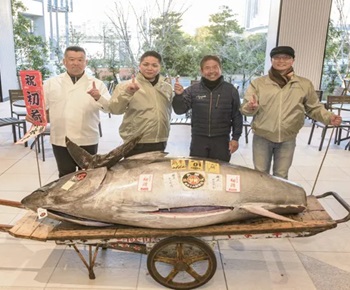 A bluefin tuna sold for $1.3 million at a predawn auction in Tokyo on Sunday morning, making it one of the most expensive tuna to be sold in the history of sushi. The 608-pound fish, equivalent in weight to a typical male grizzly bear, was caught off the coast of Oma in northern Japan’s Aomori prefecture on Saturday morning, according to Japan’s Kyodo News agency. The fish was sold to a Michelin-starred Japanese sushi restaurant chain for 207 million yen, the Onodera Group said in a statement about its winning bid. The first auction of the year at Tokyo’s Toyosu Market – one of the world’s largest wholesale fish markets – typically reels in eye-watering prices. more, >>CLICK TO READ<< 07:45
A bluefin tuna sold for $1.3 million at a predawn auction in Tokyo on Sunday morning, making it one of the most expensive tuna to be sold in the history of sushi. The 608-pound fish, equivalent in weight to a typical male grizzly bear, was caught off the coast of Oma in northern Japan’s Aomori prefecture on Saturday morning, according to Japan’s Kyodo News agency. The fish was sold to a Michelin-starred Japanese sushi restaurant chain for 207 million yen, the Onodera Group said in a statement about its winning bid. The first auction of the year at Tokyo’s Toyosu Market – one of the world’s largest wholesale fish markets – typically reels in eye-watering prices. more, >>CLICK TO READ<< 07:45
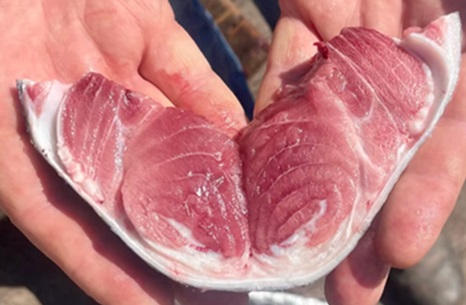
‘More fat, more flavour’: Why PEI tuna is selling at its highest price in decades
“We’re seeing prices range from $10 or $11 on the low side to $40, $50, $60 a pound on the high side. So these are higher prices than we’ve seen, probably since the early 90s,” said Jason Tompkins, owner of TNT Tuna in North Lake, which buys and exports about three-quarters of Canada’s bluefin tuna quota. Tompkins says in a normal season, just “one or two” of the roughly 1,500 tuna caught off the northeast coast of P.E.I. will earn the boat more than $10,000, after being sold on high-end markets around North America, Europe and Japan. So far this year? photos, more, >>CLICK TO READ<< 06:50
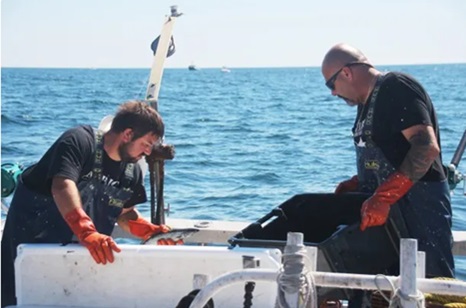
‘Wicked Tuna’ to End With Season 13 on National Geographic
“Wicked Tuna” has been canceled by National Geographic following the conclusion of its Season 13 run. “After thirteen seasons on the high seas and more than 200 incredible episodes, the long-running series ‘Wicked Tuna’ has concluded its run on National Geographic,” the cable channel said in a statement Friday. “The series celebrated one of America’s oldest industries since first premiering on National Geographic in 2012 and made internationally recognizable stars out of the intrepid commercial fishermen who brave the unrelenting North Atlantic waters to catch the elusive bluefin tuna. The cancellation of “Wicked Tuna” comes amid major cost cutting at National Geographic parent company Disney, which is consolidating operations among its linear TV networks. more, >>CLICK TO READ<< 18:01
Predators take big bite out of declining Atlantic mackerel population
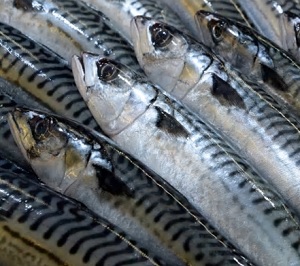 Predators ate at least twice as many Atlantic mackerel as commercial fishery landings in the decade leading up to Canada’s region-wide moratorium, according to new research by Canadian and American scientists. The study also found seals are a major predator, lending credence to what many fishermen have long claimed. The modelling study was published this month by the federal Fisheries Department and the Canadian Science Advisory Secretariat. The top predators were gannets, grey seals, dogfish and bluefin tuna. In the most conservative estimate, predators removed between 21,000 and 29,000 tonnes annually between 2012 and 2021 — at least two times greater than Canadian commercial landings reported as 11,000 tonnes per year. more, >>CLICK TO READ<< 12:26
Predators ate at least twice as many Atlantic mackerel as commercial fishery landings in the decade leading up to Canada’s region-wide moratorium, according to new research by Canadian and American scientists. The study also found seals are a major predator, lending credence to what many fishermen have long claimed. The modelling study was published this month by the federal Fisheries Department and the Canadian Science Advisory Secretariat. The top predators were gannets, grey seals, dogfish and bluefin tuna. In the most conservative estimate, predators removed between 21,000 and 29,000 tonnes annually between 2012 and 2021 — at least two times greater than Canadian commercial landings reported as 11,000 tonnes per year. more, >>CLICK TO READ<< 12:26
Frustrated fishermen get good news: good rockfishing, salmon fishing to return in 2024
 With an oversized head, bulbous eyes and narrow body, the quillback rockfish looks like a golden bullfrog armed with a quiver full of arrows on its back. Few sport fishermen want to keep, much less eat, the famously sharp and ouchy and skinny quillback, which are reeled by those seeking meatier rockfish. But it was the quillback, which is often tossed back into the sea, whose population plummet caused a shutdown that impacted the entire rockfish industry, both for commercial and for party boats operating out of Mendocino Coast’s Noyo Harbor. That mysterious plunge in quillback numbers cut off all near-shore rockfish fishing last year, causing an organized outcry by fishermen and a new plan for 2024. Photos, more, >>click to read<< 07:15
With an oversized head, bulbous eyes and narrow body, the quillback rockfish looks like a golden bullfrog armed with a quiver full of arrows on its back. Few sport fishermen want to keep, much less eat, the famously sharp and ouchy and skinny quillback, which are reeled by those seeking meatier rockfish. But it was the quillback, which is often tossed back into the sea, whose population plummet caused a shutdown that impacted the entire rockfish industry, both for commercial and for party boats operating out of Mendocino Coast’s Noyo Harbor. That mysterious plunge in quillback numbers cut off all near-shore rockfish fishing last year, causing an organized outcry by fishermen and a new plan for 2024. Photos, more, >>click to read<< 07:15
Massive bluefin tuna weighing more than 500 pounds reels in almost $800,000 at Tokyo auction
 The most expensive piece of seafood at Tokyo’s largest fish market sold for a ton-a money at auction on the opening day of business. The mammoth bluefin tuna weighing nearly 525 pounds was purchased by seafood wholesaler Yamayuki and a sushi chain for nearly $800,000. Yamayuki and sushi chain Onodera group have purchased the market’s priciest fish of the new season for four years running. “If we were going to do it, we wanted to win,” Yamayuki president Yukitaka Yamaguchi told a throng of reporters that had assembled upon the auction’s conclusion. Video, photos, >>click to read<< 09:08
The most expensive piece of seafood at Tokyo’s largest fish market sold for a ton-a money at auction on the opening day of business. The mammoth bluefin tuna weighing nearly 525 pounds was purchased by seafood wholesaler Yamayuki and a sushi chain for nearly $800,000. Yamayuki and sushi chain Onodera group have purchased the market’s priciest fish of the new season for four years running. “If we were going to do it, we wanted to win,” Yamayuki president Yukitaka Yamaguchi told a throng of reporters that had assembled upon the auction’s conclusion. Video, photos, >>click to read<< 09:08
Bluefin Tuna Get Busy Off North Carolina – Inside the $40 billion tuna industry
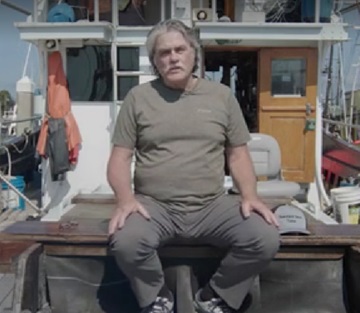 In November 1981, a fleet of briefcase-toting lobbyists, scientists and political negotiators gathered in sunny Tenerife, Spain, to decide the fate of Atlantic bluefin tuna. During the meeting in Tenerife, the American delegation to the International Commission for the Conservation of Atlantic Tunas proposed a disarmingly simple solution: they would draw a line down the middle of the Atlantic Ocean and split the bluefin into two separate stocks. The proposal passed and, eventually, for a variety of reasons, Atlantic bluefin tuna did bounce back. – Inside the $40 billion tuna industry – Once a staple in American homes, canned tuna consumption dropped 45.7% between 2000 and 2021. That is mainly due to changing consumer preferences, sustainability concerns, market consolidation and a major price-fixing scandal between Bumble Bee and StarKist that lasted nearly a decade. Despite this, in 2020, the U.S. remained the top importer. The industry, largely controlled by conglomerates such as Thai Union Group, saw a pandemic-driven demand spike in 2020, but that has since declined. Video, >>click to read<< 16:20
In November 1981, a fleet of briefcase-toting lobbyists, scientists and political negotiators gathered in sunny Tenerife, Spain, to decide the fate of Atlantic bluefin tuna. During the meeting in Tenerife, the American delegation to the International Commission for the Conservation of Atlantic Tunas proposed a disarmingly simple solution: they would draw a line down the middle of the Atlantic Ocean and split the bluefin into two separate stocks. The proposal passed and, eventually, for a variety of reasons, Atlantic bluefin tuna did bounce back. – Inside the $40 billion tuna industry – Once a staple in American homes, canned tuna consumption dropped 45.7% between 2000 and 2021. That is mainly due to changing consumer preferences, sustainability concerns, market consolidation and a major price-fixing scandal between Bumble Bee and StarKist that lasted nearly a decade. Despite this, in 2020, the U.S. remained the top importer. The industry, largely controlled by conglomerates such as Thai Union Group, saw a pandemic-driven demand spike in 2020, but that has since declined. Video, >>click to read<< 16:20
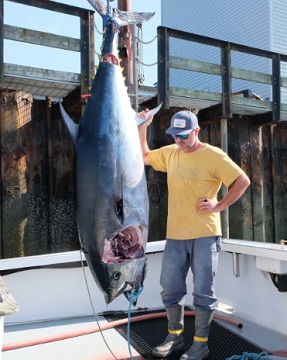
From the Gulf of Maine to a tin can: A glimpse into high-end tuna production on NH’s coast
“I left today at, like, 12 midnight,” he said, his face hidden behind mirrored sunglasses and a beard. “And then it’s about an hour and a half ride out, and it was beautiful last night because that big fat moon is waning.” Keper Connell is a one-man operation aboard his boat, The Figment. When conditions allow, he cruises into the Gulf of Maine in search of bluefin tuna, a torpedo-shaped fish that can reach more than 1,000 pounds. Rather than sell his bluefin to a wholesaler, where cuts may end up in a fishmonger’s display case, or as toro on a sushi menu, Connell is doing something that nobody else in the U.S. is apparently doing. His fish is put on ice and sent to Oregon, where it will be packed into tin cans with a high end olive oil and some salt. (There are no canneries on the East Coast where an independent fisherman can bring his catch, he says.) Photos, >>click to read<< 11:07
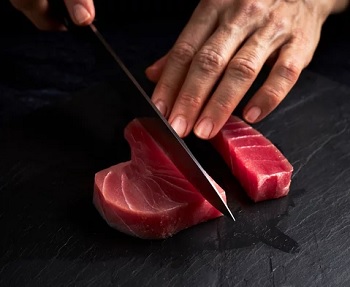
Why Bluefin Tuna Is Considered the Best Tuna Variety by Many
In case you haven’t been acquainted, meet bluefin tuna, the luxurious seafood superstar. According to Fishing Booker, the bluefin is prized for its delicious meat, and it comes with a price tag of royal proportions. Until the 1970s, says The New Yorker, fishmongers didn’t so much as bat an eye at the good old bluefin, often selling the delicacy for less than one dollar per pound. Today, though, a single piece of bluefin sashimi at Nobu Chicago runs for $20, and it gets even pricier. >click to read< scroll down for 15 ways to cook fish! 18:29
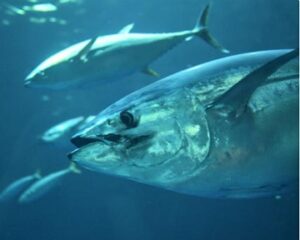
The Largest Bluefin Tuna Ever Recorded Was Caught Off the Coast of Nova Scotia
The Atlantic Bluefin tuna is the largest species of the Scombridae family and is known to reach speeds of 43mph in the ocean. While most of the Atlantic Bluefin tuna range between 500 to 1000 lbs, some are known to tip the scale at 1,500lbs! Per reports, the largest Bluefin tuna ever caught was in 1979 and weighed a whopping 1,496lbs: “Not only is Ken Fraser’s bluefin the biggest tuna ever recorded by the International Game Fish Association, it is also one of the most iconic records of all time. He landed the world record bluefin tuna on October 26, 1979, fishing with Capt. Eric Samson aboard Lady and Misty out of Port Hood, Nova Scotia. >click to read< 08:11

Why Canada shuttered some mackerel and spring herring fisheries in Québec and Atlantic Canada
The announcement by the Department of Fisheries and Oceans to suspend fishing for Atlantic mackerel and spring herring in the southern Gulf of St. Lawrence made waves as the fishing season opened. This decision will have repercussions on the fishing industry at several levels since these species are fished not only for commercial purposes, but are also used as bait in the lobster, snow crab and Atlantic halibut fisheries. The latest stock assessment of Atlantic mackerel and spring herring in the southern Gulf of St. Lawrence revealed high mortality rates among adult fish. In addition to high fishing pressure, the natural mortality of fish by predation also increased rapidly, The grey seal, now 16 times more abundant than in the 1960s, is the main predator of herring. >click to read< 18:38

‘Wicked Tuna’ returns for Season 11
The tuna fishermen in the National Geographic hit series “Wicked Tuna” were not crushed by the global COVID-19 pandemic, although they too faced the challenges of a world economy turned upside down. But the “monstah” bluefin tuna competition is back. Season 11 kicks off on NatGeo TV with the extended 90-minute episode “Back on the Hunt” this Sunday, Feb. 27, at 9 p.m. Filmed on location in Gloucester and at sea, the show follows experienced fishermen from the nation’s oldest seaport, chronicling their triumphs and sometimes the ones that get away. Of the eight captains, half are from Gloucester, and two are from Beverly. The other two are from New Hampshire and New Jersey. >click to read< 21:24
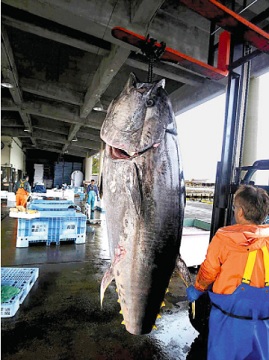
Increased quota offers ray of hope for bluefin tuna fishing industry
The decision to increase the quota cheered Takao Iwane, a 73-year-old fisherman who has plied the Sea of Japan waters off the town of Fukaura, Aomori Prefecture, for about 40 years. “Bluefin tuna prices go up in winter, so the announcement encouraged me,” said Iwane, who catches tuna using a handheld line with a single hook. Fukaura is known as one of the rock stars of Japan’s tuna fishing industry. Fishermen could operate without restrictions in waters off Fukaura several decades ago, but catches plunged around the time after regulations were introduced in 2015. In 2021, the four fishery cooperatives in Fukaura were allocated a combined quota of 302 tons. >click to read< 23:18
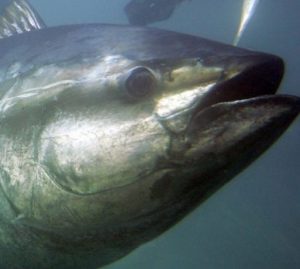
The Bluefin Tuna Trophy angler season closed in March. Normally it would last into June.
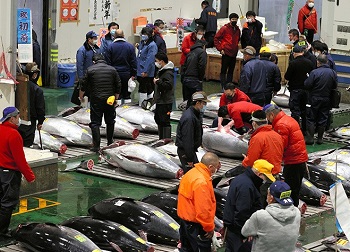
Bluefin tuna sells for low pandemic price at Toyosu’s 1st 2021 auction
The most expensive bluefin tuna sold under the hammer at 2021’s first auction at Tokyo’s Toyosu fish market failed to land a million-dollar bid or anything close on Jan. 5, reflecting the chill the novel coronavirus pandemic has on the restaurant industry. The 208.4-kilogram fish caught off Oma, Aomori Prefecture, went for just 20.8 million yen ($202,270) to Yamayuki, the market’s intermediary wholesaler.,,, Minoru Tanaka, 65, the captain of a tuna trawler based in Oma, caught the fish. 5 photos, >click to read< 10:30

Do you think your seafood is cheaper? It is. The Coronavirus pandemic caused a drop in demand
The ongoing pandemic has impacted nearly every aspect of life on the South Shore, including the commercial fishing and lobster industries. “It’s hurt them big time,” said retired Cohasset fisherman Matt Marr. “There are so many things that factor in. Most of the restaurants are closed, hotels are empty, casinos are empty, cruise ships don’t exist anymore. Those places bought a lot of lobster. So, their markets have definitely diminished.” Reduced business at restaurants has caused a significant drop in demand, said Tommy Alioto. The pandemic didn’t affect lobstermen’s ability to do their job, but the low demand caused an excess of inventory and a drop in price. >click to read< 15:30
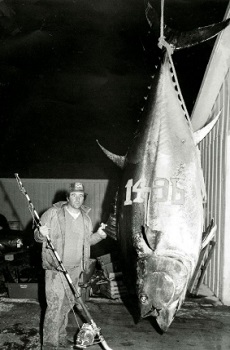
A Tuna’s Worth – Inside a Canadian fishery that pursues them
Bluefin tuna are a luxury that feeds the egos of many, the bellies of few.,, North Lake, a community too small to support an ATM, calls itself the tuna capital of the world. In the 1960s and 1970s, anglers here regularly landed bluefin that broke world records. People came from all over the planet to hunt the storied giants, which swam faster and fought harder and grew bigger than any other sport fish. In 1979, a North Lake fisher named Ken Fraser caught the largest in history, at 679 kilograms. In a black-and-white photo commemorating the event, Fraser stands wide-eyed, blood-spattered, and completely dwarfed by the hanging behemoth—as if he were the prey, not the predator.,, On the other side of the world, in Japan, bluefin was well on its way to becoming the most expensive item on sushi menus. photos, >Audio report, click to read< 09:57

Is It Time To Start Eating Western Atlantic Bluefin Tuna? Yes, it is, Margot! Its Sustainable!
Back in January, the Monterey Bay Aquarium Seafood Watch quietly changed their sustainability rating for western Atlantic bluefin tuna from Avoid to Good Alternative. Their report states that Atlantic bluefin caught using more sustainable fishing practices (e.g., rod and reel, harpoon, or larger fishing nets called purse seines) are a good alternative to higher risk commercially fished options. The authors note that additional research would need to be done to prove definitively that the Atlantic bluefin is no longer overfished, but the evidence points toward a healthy stock. They cite low bycatch in the handline and harpoon fisheries and “moderately effective” management as reasons for the changing the rating. Randy Blankinship, chief of NMFS’ Highly Migratory Species Management Division was quoted saying “when seafood consumers purchase Atlantic bluefin tuna caught in the United States, they’re supporting robust environmental standards that bolster both bluefin populations and our economy.” This should be good news, but it’s hardly been news at all. >click to read< 08:24
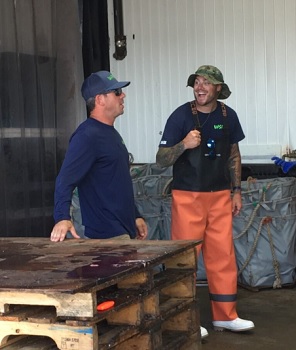
Maine Fishermen Zack Plante and Charlie Boivin, are on the new season of ‘Wicked Tuna’ along with Bob Cook of Beverly, Ma!
Zack Plante and Charlie Boivin will be featured on the ninth season of National Geographic’s reality TV show “Wicked Tuna,” beginning Sunday. They’ll be seen fishing out of their 35-foot boat, Wasabi. The point of the show is to see which crew hauls in the most bluefin tuna by season’s end, while highlighting the competitiveness and drama on the high seas along the way. Boivin and Plante are among three new crews on the show this season, competing against several other boats that have been on the show before. As the only boat from Maine, Boivin and Plante – the latter of whom a news release described as “ready to stir the pot” – went into the show with a little bit of a chip on their shoulders. >click to read< 20:10
 Beverly’s Bob Cook joins ‘Wicked Tuna’ – Beverly native Bob Cook has joined the cast and will make his debut aboard the Fat Tuna when the series’ ninth season gets underway this Sunday. For Cook, appearing on “Wicked Tuna” has been nearly a decade in the making. >click to read<2/28, 11:18
Beverly’s Bob Cook joins ‘Wicked Tuna’ – Beverly native Bob Cook has joined the cast and will make his debut aboard the Fat Tuna when the series’ ninth season gets underway this Sunday. For Cook, appearing on “Wicked Tuna” has been nearly a decade in the making. >click to read<2/28, 11:18
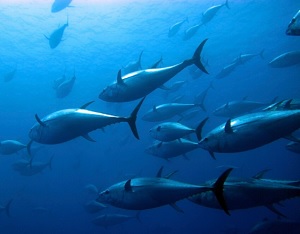
The $2 million fish? Jersey fishermen calling on government to allow targeting the bluefin tuna market
Don Thompson, president of the Jersey Fishermen’s Association, said Jersey should look to Prince Edward Island, the smallest Canadian province, whose industry for commercial and charter boat tuna fishing is worth about $2 million a year. In recent years, fishermen have reported seeing an ‘abundance’ of Atlantic blue fin tuna – which are classified as endangered – around the Island in the summer months but there is a total ban on catching them for Jersey vessels. No such ban applies to French boats. French newspaper Ouest France reported that 5.4 tonnes of tuna were landed at Granville market last year. A single fish can be worth thousands of pounds. >click to read< 21:18
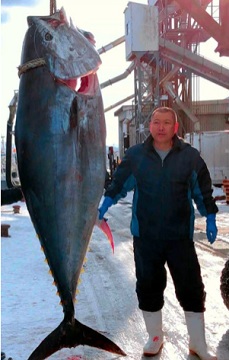
“New Year’s happy news.” Fishing boat reels in $1.79 million tuna to start the year
Captain Masahiko Yamamoto has the fish story of the new year, the day he hit the lottery at sea, landing a million-dollar catch. Yamamoto, 57, was on his boat when he heard that a 276-kilogram bluefin tuna he landed sold at the first auction of the year at the Toyosu fish market in Tokyo on Jan. 5. The winning bid of 193.2 million yen ($1.79 million) from a Tokyo-based sushi chain operator was the second-highest ever in the New Year’s auction.,, The waters here have produced tuna fetching the highest price in the New Year’s auction for nine consecutive years, making Oma famed as the “pole-and-line fishing bluefin tuna town.” >click to read< 11:22

In her garage lab, a scientist looks for answers about skinny tuna
Molly Lutcavage is standing on the State Fish Pier in Gloucester, watching a crane hoist a giant bluefin tuna off the back of a fishing boat. “Look at how skinny she is,” the fisherman, Corky Decker, yells up to her. “That’s how they’ve all been — long, ugly things like you’d catch in June.” Lutcavage nods at the fish, which is 74 inches long but weighs just 174 pounds — very skinny indeed for a tuna — then looks down at the plastic bag in her hands, which is what she’s come for. It contains the tuna’s ovaries,,, >click to read< 07:38
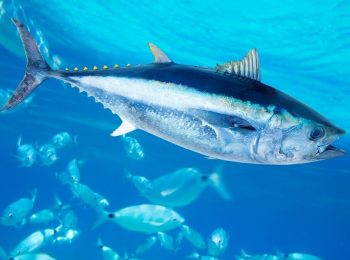
Bluefin tuna shoals off Jersey ignite fishing quota debate
Jersey’s commercial fishing fleet wants their share of an emerging bluefin tuna market which is currently being exploited by French crews. For the second consecutive year bluefin tuna have been seen in huge numbers in Jersey waters.,,,Don Thompson, chairman of the Jersey Fishermen’s Association, said he was drafting a proposition to present to the Fisheries and Marine Resources Panel calling for laws to be relaxed. Commercial fishermen in Jersey and the UK currently have no allocated quota to land bluefin tuna. France does have a bluefin quota, with Gallic fishermen able to land and sell the fish,,, >click to read< 19:31
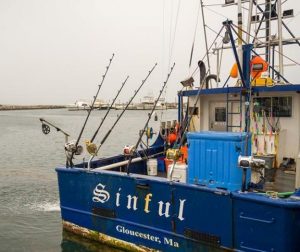
Once Robust, Bluefin Tuna Fishery Is In Economic Freefall
Carl Coppenrath can remember the days when it seemed bluefin tuna fishermen could walk on water. In the heyday of the 1980s, the market was so flush in Menemsha that fishermen could literally walk across a harbor packed with a fleet of commercial vessels lined up at the end of the day to sell their catch for top dollar. The mystique and allure of catching the torpedo-shaped fish that can weigh over 1,400 pounds brought glory and the prospects of such wealth that it awoke the romantic reimagination of the old whaling days of the Island. So much so that it spawned the popular cable TV series Wicked Tuna and lit up social media with photos and boastful tales of the trophy fish. “It’s like an addiction . . . >click to read< 21:29
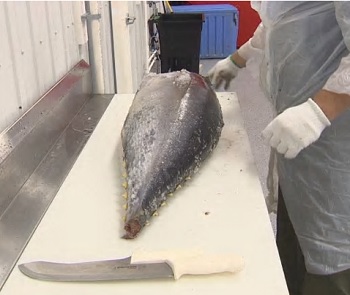
P.E.I. tuna processing plant opens up new markets, bigger profits
A tuna buyer in North Lake, P.E.I., has just opened what he says is Canada’s first federally-approved bluefin tuna processing facility. The cut house, as it’s called, uses traditional Japanese knives to process the tuna. Jason Tompkins has been in the tuna business for 18 years, the last six as a buyer in North Lake. He said it was time to find a new way to sell tuna from Prince Edward Island. >click to read< 09:43
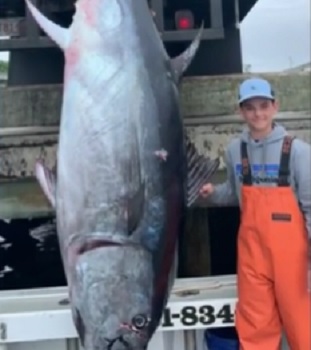
14-year-old reels in massive 600-pound tuna off Marshfield
A 14-year-old fisherman from Marshfield made the catch of a lifetime Thursday, reeling in a 600-pound tuna. Anthony Tavares and his father, Marshfield Police Chief Phillip Tavares, were out on a commercial fishing boat when he snagged the 151-inch Atlantic Bluefin Tuna weighing in at 686 pounds. Tavares said he has been fishing for as long as he can remember but has never caught anything this big before.,,, Tavares said fishing has taught him important life lessons about perseverance and believing in oneself. “If you keep believing, it will happen,” he said. “Dreams can come true.” >click to read< 08:05
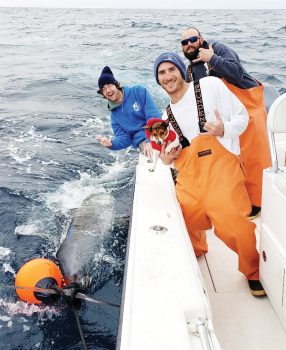
Making the Cut! – Former Wilsonian featured on “Wicked Tuna: Outer Banks”
As a boy, Daniel Blanks fished all the little farm ponds around Wilson County. On Sunday night, Blanks will be featured on the popular National Geographic television series “Wicked Tuna: Outer Banks” as he and commercial fishing partner Zack Shackleton angle for bluefin tuna 40 miles off the North Carolina coast in the Atlantic Ocean.,, Then this year, the “Wicked Tuna” producers were looking for new captains. Blanks’ girlfriend sent in an application to “Wicked Tuna” hoping to get on the show. “We were kind of joking about it saying they would never pick a little boat like us to be on and sure enough, they called us,” >click to read<08:41 9 p.m. Sunday
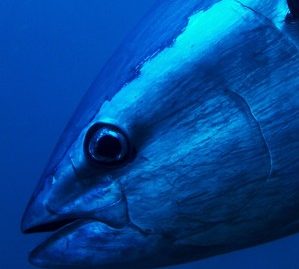
Exploring Potential Changes in Bluefin Tuna Management
NOAA Fisheries announces the availability of a scoping document on Amendment 13 to the 2006 Consolidated Atlantic Highly Migratory Species Fishery Management Plan and our intent to prepare an environmental analysis under the National Environmental Policy Act. Issues and options paper The issues and options paper explores management options with a focus on: Refining the Individual Bluefin Quota Program. Reassessing share distribution and allocation of bluefin tuna quotas, including the potential elimination or phasing out of the Purse Seine category. Other regulatory provisions regarding the directed and incidental bluefin fisheries. >click to read<11:19
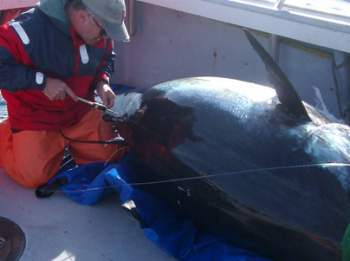
Commercial fishermen in Port Hood area played integral role in bluefin tuna project
The lead researcher for a project diving into the world of giant bluefin tuna says the work of commercial fishermen in the Port Hood area played an integral role in the project. Work done as part of a decade-long Tag-A-Giant (TAG) study of tagged Atlantic bluefin tuna was published last week in a scientific journal.,,, A team from the Tag-A-Giant campaign has toiled in areas including the waters off of Port Hood for more than a decade now. >click to read<18:52








































